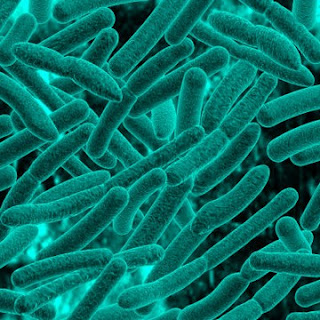Kingdom Monera - All the organisms of this kingdom are
prokaryotes. Complex structure was the basis of classification of
organisms, many centuries ago. According to R.H. Whittaker's five
kingdom classification all the bacteria were placed under the Kingdom
Monera.Monera are considered as the most primitive group of organisms. They include various types of bacteria and blue-green algae.Monerans are most abundant of all organisms, due to their versatility of their habitat.It is estimated that a single drop of water contains 50 billion bacteria.
The Kingdom Monera includes organisms that are single-celled known as bacteria. The microorganisms in Kingdom Monera are considered as the most ancient living forms on earth. The kingdom is divided into two groups Archaebacteria and Eubacteria. All
the organisms of this kingdom are prokaryotes. These cells do not have
nuclear membrane, the chromosome is a single and circular, they also
lack membrane bound cellular organelles. This kingdom
includes bacteria, cyanobacteria, mycoplasma etc. They are unicellular
organisms and do not have specific mode of nutrition. They can be either aerobic or anaerobic.These organisms have cell wall which is made up of peptidoglycans. The cell organelles are not membrane bound. Cell organelles like endoplasmic reticulum, mitochondria are absent. Reproduction is by spore formation and binary fission.
General characteristics of the kingdom Monera are as follows:
- They are primitive organisms.
- All organisms of the kingdom are prokaryotes.
- They are present in both living and non-living environment.
- They can survive in harsh and extreme climatic conditions like in hot springs, acidic soils etc.
- They are unicellular organisms.
- Membrane bound nucleus is absent.
- DNA is in double stranded form, suspended in the cytoplasm of the organism,referred as nucleoid.
- A rigid cell wall is present.
- Membrane bound cellular organelles like mitochondria are absent.
- Habitat - Monerans are found everywhere in hot springs, under ice, in deep ocean floor, in deserts and on or inside the body of plants and animals.
- Nutrition - autotrophs - can prepare their own food, heterotrophs - depend on others for food, saprophytes - feed on dead and decaying matter, parasitic - live on other host cells for survival and cause, symbiotic - in mutual relation with other organisms, commensalism - it is where one organism is benefited and the other is not affected, mutualism - where both the organisms are benefited.
- Respiration - respiration in these organisms vary, they may be obligate aerobes - the organisms must have organisms for survival; obligate anaerobes - the organisms cannot survive in the presence of oxygen; facultative anaerobes - these organisms can survive with or without oxygen.
- Circulation - is through diffusion.
- Movement - is with the help of flagella.
- Reproduction is mostly asexual, sexual reproduction is also seen.
Reproduction in BacteriaReproduction in bacteria is
mainly by fission.Under unfavourable conditions they reproduce by
spores. Sexually bacteria reproduce by a primitive mode of DNA transfer
from one bacterium to another i.e., by conjugation, transduction
or transformation.
Mycoplasma
Mycoplasma are the known to be the smallest living cells. They completely lack cell wall and can survive without oxygen. Most of the mycoplasma are pathogenic in nature in animals and plants.
Economic Importance of Bacteria
Lactic acid bacteria like Lactobacillus and Lactococcus have been used in fermentation process for thousands of years.The ability of the bacteria to degrade variety of organic compounds has been used in waste management processing and biorememdiation.In pest control, bacteria can be used in the place of pesticides as these pesticides are regarded environmentally friendly.
Example: Bacillus thuringenesis.
The ability of the bacteria in dividing rapidly and by studies on the bacterial genome, these bacteria can be bio-engineered for the production of therapeutic proteins like insulin, growth factors and antibodies, etc.
By
Aswathy.V S


No comments:
Post a Comment